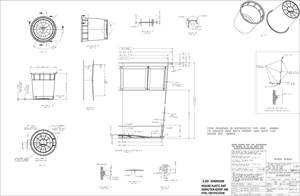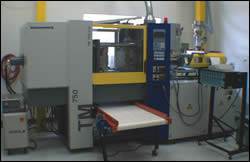Mold Tryout - Ensure That Your Mold Makes the Grade
As moldmakers try to survive and thrive in this fiercely competitive business climate, it makes sense to offer their customers the most complete service possible.
As moldmakers try to survive and thrive in this fiercely competitive business climate, it makes sense to offer their customers the most complete service possible. Sampling/testing and trying out molds before they leave the shop floor not only satisfies the customer, it may save the moldmaker the headache of reworking the mold. However, performing this service in-house may not be feasible, so it may pay to outsource - resulting in the moldmaker saving time, money and space.
"Customers nowadays don't just want a tool built," asserts Gerald Sommers, president of Buffalo Grove, IL-based Courtesy Corporation. "They want the tool designed, built, certified, sampled and validated. Offering the validation service gives us credibility during all phases of toolmaking."
Additional benefits of outsourcing, Sommers notes, include no capital expenditure for molding presses, and not having to learn another core competency. It is important that the moldmaker be prepared before beginning the search for an outside source. "The tooling house should have knowledge of the following: resins, injection molding process, all sampling options and the scientific molding process," Sommers says. "They should also create a sample run request form and a mold function checklist(see below). Also, the tooling house should be present when sampling is performed."
Sampling Options
Option A - Steel Verification
Inspection:
- Measurements are performed in the metrology lab.
- Measure only flagged or critical to function dimensions. A discussion is required with the customer regarding how the dimensions will be measured prior to quoting the cost.
Option B - Basic Sample
Process:
- Dry cycle mold.
- Determine the initial processing parameters per visual and dimensional results (does not include cycle optimization).
- Develop cycle sheet for the sample process.
- Review product with customer and/or Courtesy customer contact.
Inspection:
- Visual
- Dimensional
- Measurements are done at the press by molding technician.
- Limited to two dimensions.
- Does not include service from the metrology or quality departments.
Option C - Basic + Metrology
Includes items shown in Option B, plus:
- Measurements are performed in the metrology lab.
- Check only flagged or critical to function dimensions.
Option D - First Article Inspection
Includes items shown in Option C, plus:
Process:
- Refine initial process established during basic sample.
Inspection:
- Measurements are taken from only one shot.
- Measure dimensions shown on the part drawing. A discussion is required with the customer regarding the exact dimensions prior to quoting the cost.
Option E - Tool Capability
Includes items shown in Option D, plus:
Process:
- Requires a customer-approved process.
- Start-up shot inspected and approved by metrology.
- Run mold for four hours.
- One shot is collected and isolated every 10 minutes (25 individual shots total).
- Changes to process parameters result in a restart of the capability run.
Inspection:
- Done by metrology.
- Measure only flagged or critical-to-function dimensions.
- Inspection report includes basic statistical analysis and SPC charts (i.e., mean, standard deviation, Cpk, Ppk, histograms, X-bar and R charts, etc.)
Option F - Process Validation
Includes items shown in Option E, plus:
Process:
- This run consists of a 24-hour run followed by two four-hour runs.
- Process developed during tool capability run is used.
- Dimensional relationships between the cavities are established during the tool capability run.
- During the 24-hour run, 25 sample shots are collected.
- Each of the four-hour runs is conducted using a different lot of raw material resin. During each of these runs, 25 shots are collected.
- Changes to process parameters result in a restart of the validation run.
Inspection:
- The dimensional protocol for the samples collected during these four runs follows that of the tool capability sample.
According to Al Fox, president of Accede Mold & Tool Co., Inc. (Rochester, NY), a high cavitation mold builder, "Any moldmaker who builds a mold and does not test it prior to shipping to his customer is asking for trouble, risking the opportunity to solve any problems prior to the customer having possession of the mold."
Selecting a Sampler
When a moldmaker makes the decision to have a mold tested, he or she should seriously consider the quality of the equipment the outsourcer uses. "Beware of people using older equipment," Fox warns. "You will not get a good sample. Also look at the quality of the sample or test itself."
First and foremost, says Sommers, "Look for a molder who will work with you. He is doing you a favor for this inconvenience to his business." Fox adds, "Communication is essential - you must visit the facility that is doing the testing, and bring those who are involved in the mold build process with you. For example, you should bring a moldmaker and an engineer along, as well as someone with processing or inspection knowledge. It takes time and manpower."
Sommers recommends that moldmakers consider the following questions in the search for the proper mold house to send mold tryout work:
- Does the molding house have a good process engineer?
- Is the molding house a pellet maker or does he or she understand process molding and scientific molding?
- Does the molding press have new presses for mold tryout?
- Are the presses equipped with SPE software?
- Does the molder have an overhead crane for large mold setup?
- Does the molding house possess both large and small presses, with a variety of barrel sizes to pick from?
- Does the molder have good setup people?
Usually, molds will sample more than once - the minimum is two to three times - Fox points out. "The first sample is generally for mechanical issues to be sure that everything is functioning properly; and the second sample is to measure the dimensional stability of the part and to try to meet the customer's cycle requirements."
Although it will cost you added time and money, taking this extra step to thoroughly try your molds before they are out the door ensures repeat business and enhances your reputation as a competent mold builder. This is one test you can't afford to skip
Related Content
Tolerancing in Mold Design, Part 1: Understanding the Issues of Conventional Bilateral Tolerancing
Mold designers must understand the location, orientation and form limitations of conventional tolerancing before changing to another dimensioning system.
Read MoreHow to Select a Mold Temperature Controller
White paper shares how cooling channel analysis, which collects maximum pressure drop, total flow rate and heat dissipation, eases the performance evaluation of mold temperature controllers.
Read MoreThe In's and Out's of Ballbar Calibration
This machine tool diagnostic device allows the detection of errors noticeable only while machine tools are in motion.
Read MoreIt Starts With the Part: A Plastic Part Checklist Ensures Good Mold Design
All successful mold build projects start with examining the part to be molded to ensure it is moldable and will meet the customers' production objectives.
Read MoreRead Next
Rigorous Mold Tryout: Do Your Homework
If moldmakers strive to understand how an end user will use the mold, they will help their customers become more profitable and more confident in the shop’s abilities leading to a strong partnership.
Read MoreAre You a Moldmaker Considering 3D Printing? Consider the 3D Printing Workshop at NPE2024
Presentations will cover 3D printing for mold tooling, material innovation, product development, bridge production and full-scale, high-volume additive manufacturing.
Read MoreReasons to Use Fiber Lasers for Mold Cleaning
Fiber lasers offer a simplicity, speed, control and portability, minimizing mold cleaning risks.
Read More












_300x250 1.png;maxWidth=300;quality=90)


.png;maxWidth=300;quality=90)









